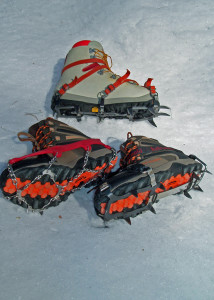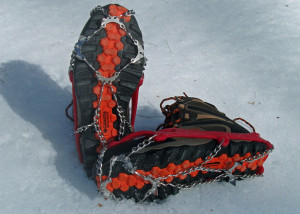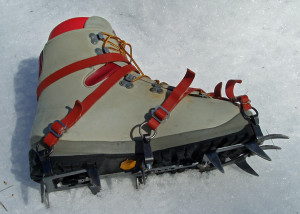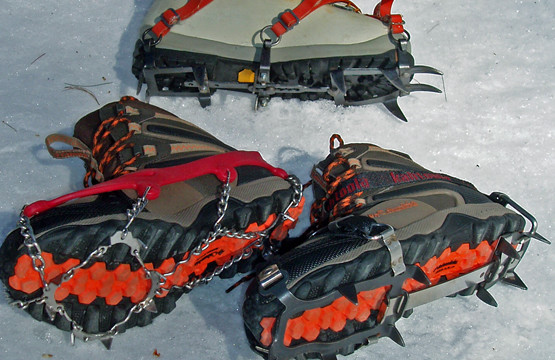
Update: EasternSlopes.com has added a complete test of Winter Hiking Trail Traction Aids.
Here in the northeast, most of us—especially those of us who like to get out and enjoy winter—put snow tires on our vehicles in October and take them off in April. Snow tires help get you where you are going safely and easily on slick roads. The only thing worse than not being able to get moving because you have no traction is not being able to stop for the same reason!
It’s the same out on the trails in winter, where not having the winter hiking traction you need can range from being slightly annoying to dangerous to deadly. If you are going to hike when there’s snow around, you need to be prepared to deal with traction issues. It all depends on the conditions you encounter. When the snow’s deep you need snowshoes. But what about when it isn’t deep yet, or was deep and has melted and refrozen?
Trail conditions can vary widely not only from day to day, but from hour to hour and, sometimes, moment to moment. What you find in one place may be very different only a few feet away. Some of the variables that can affect your footing on a winter trail include the recent weather, the steepness of the trail, what’s underneath the snow (rock, dirt, etc.), the sun and wind exposure that particular section of trail experiences, and the amount of human traffic it gets. It’s impossible to know exactly what you are going to encounter until you are out there.
Most hiking boots these days have rubber lug soles that can provide adequate traction on settled snow. They are kind of like “all season” tires, better than slicks but inadequate when the going gets tough. When snow gets rained on or melts and then re-freezes into heavy crust or ice, it gets too hard for even hard rubber soles to “bite.” You start to slip, and slips mean falls and falls mean injury. That’s when traction aids are necessary.
For simplicity sake, let’s divide traction aids into two general categories: creepers and crampons. Most modern snowshoes have traction cleats built in, too, but that’s a subject for another time.
Winter Hiking Traction Aids: Everyone Needs Trail Crampons
Creepers are designed primarily to give traction for walking or running on relatively flat ice—a frozen lake, a city sidewalk or an ice-covered hiking trail. They generally attach to your boots quickly with a rubber or nylon harness, and have some sort of metal cleats, studs, spikes or chains to bite into the surface of the ice and keep you from slipping. There are dozens of creepers on the market,

The next step up are “Trail Crampons.” The originals were “MICROspikes®” from Kahtoola. At this time of year they run about $60 (about twice the price of creepers) and are worth every penny; in the spring I’ve seen them for 40 percent off. They slip on quickly and securely with a heavy-duty polymer harness and have 3/8-inch spikes on chains which provide serious traction. Mine have lasted three long seasons so far and show no sign of giving up. I’ve used them on flat ice and even some steep trails where I could probably have justified using crampons, and they performed admirably. This is a GREAT product. If you don’t believe me, check the reviews at rei.com.
Trail Crampons in general are relatively compact, lightweight, and easy to carry. And when you need them, you need them. Get a set that fits your winter hiking boots, throw them in your pack whenever you head out on the trail. If you turn a corner and suddenly find your only route covered in slippery ice or hard crust, stop and put them on and travel safely.
Winter Hiking Traction Aids: Do You NEED Crampons?

Crampons, on the other hand, are long, sharp spikes designed to get you safely up and down steeply slanted (or even vertical!) ice and heavily crusted snow.
Here’s a fact: Crampons are serious mountaineering gear; you never need them on any normal trail. Most hikers never need them
In fact, crampons are a two-edged sword: when you need them, you need them; they can let you travel in comparative safety in conditions that could otherwise hurt or even kill you.
But having crampons can also get you into places you maybe shouldn’t go. If you don’t own an ice axe and don’t absolutely know how to use it for self-arrest if you fall on a steep slope, you have no business going where crampons are needed.
Another fact: crampons are tricky things. They can bite you. More than one intrepid mountaineer has been seriously hurt or killed because they tripped on their own crampons and fell where they shouldn’t have fallen. And many more carry scars on their lower leg above the boot top from a stumble while wearing crampons. If you are going to use crampons, you have to practice with them someplace safe before you need to rely on them on potentially hazardous terrain.
I admit I have a couple of pairs or crampons in my gear closet. Last year I purchased an elegant (but still functional) pair of crampons, hand-made in Scotland, still outfitted with buckled leather straps. Talk about retro! They are beautiful to look at but I haven’t used them yet and wouldn’t without replacing the leather straps with modern nylon. Do that, and they’d still work fine..
I also have a pair of very lightweight, flexible, easy-to-use KTS Steel crampons from Kahtoola to use when Trail Crampons just aren’t adequate.
But remember, if you THINK you need crampons, you probably don’t. When you NEED crampons, you’ll know, and you should know how to use them.
Winter Hiking Traction Aids: Worst Case Scenarios
If you want to see what can go wrong when your traction aids fail you on steep terrain, I’d suggest taking some time to read the accident reports on the Mount Washington Avalanche Center’s website. Mount Washington isn’t the only place accidents happen, but it is a place where they get documented. Spend some time reading: it might keep you from making a rookie mistake that gets you into trouble.



Thanks for the article. I wound up buying Katoolas. Great device for winter hiking in New England.